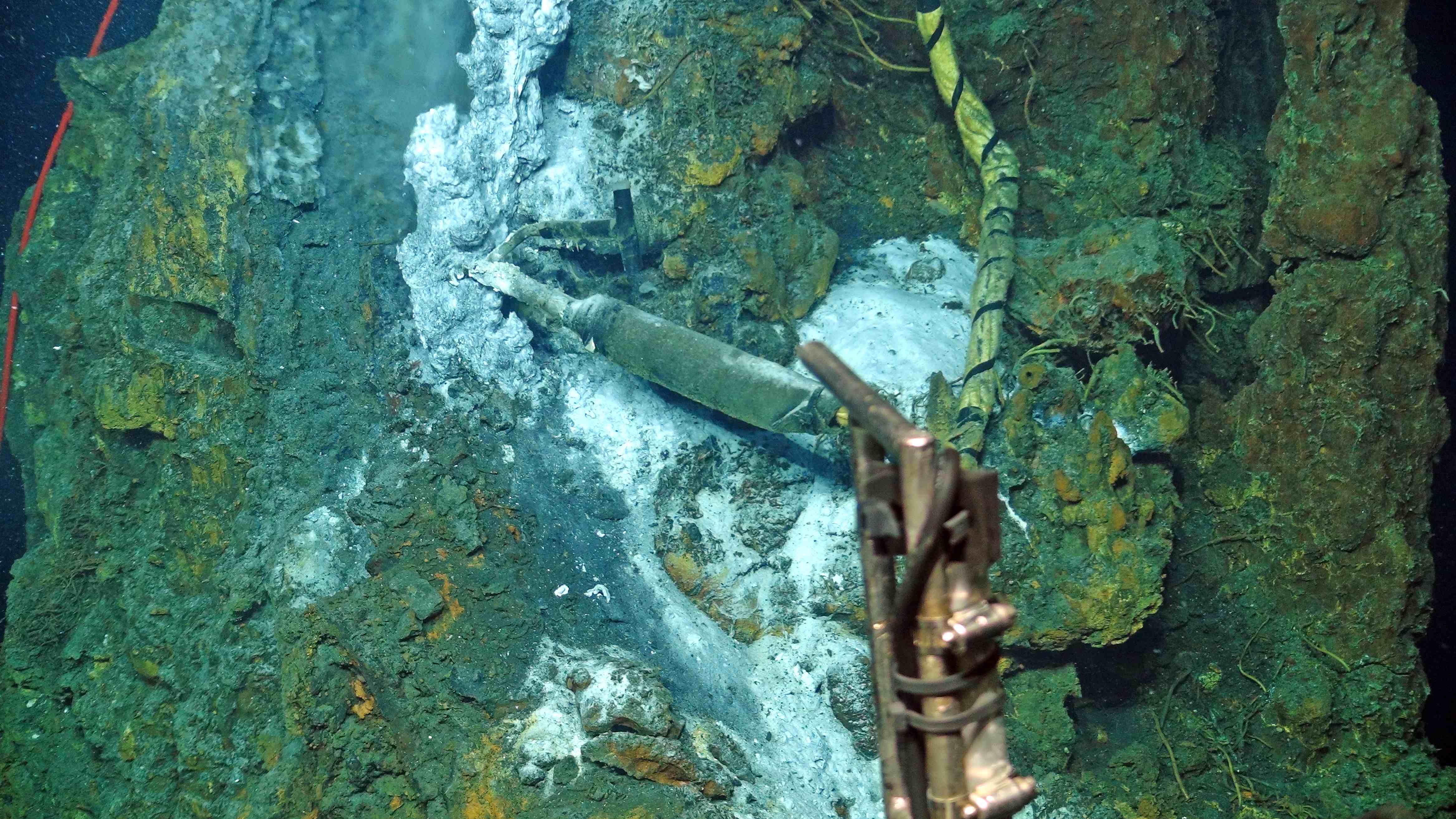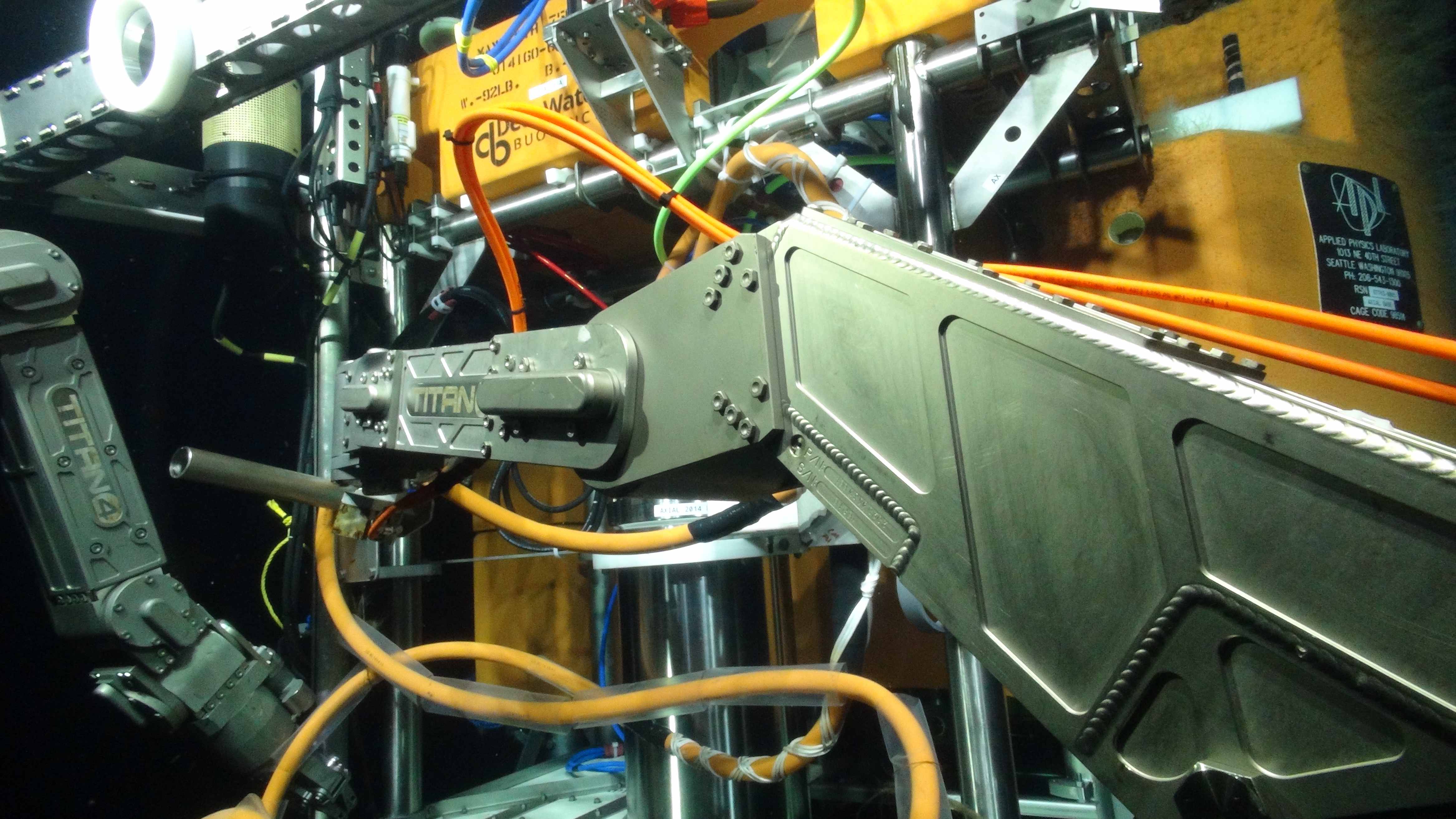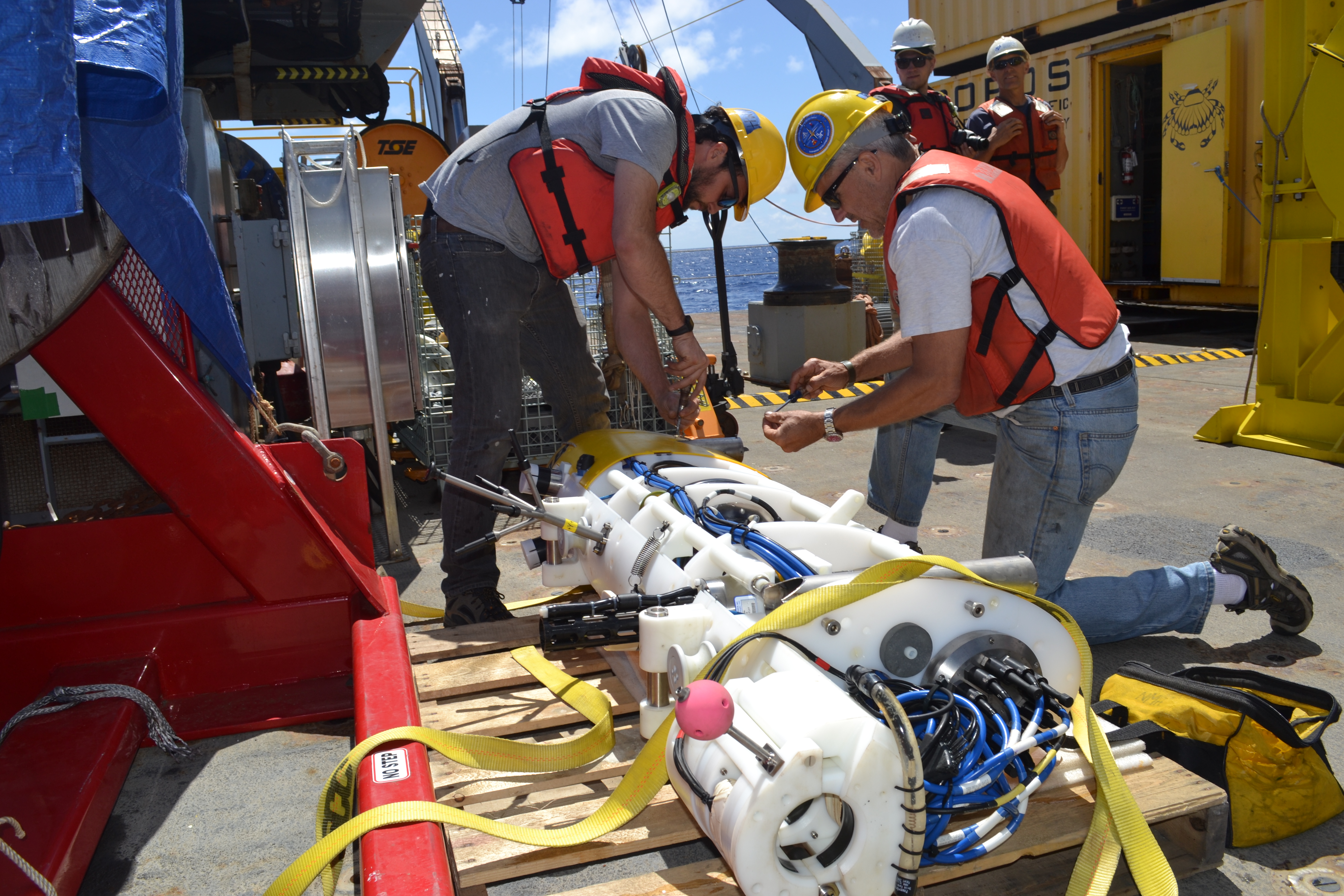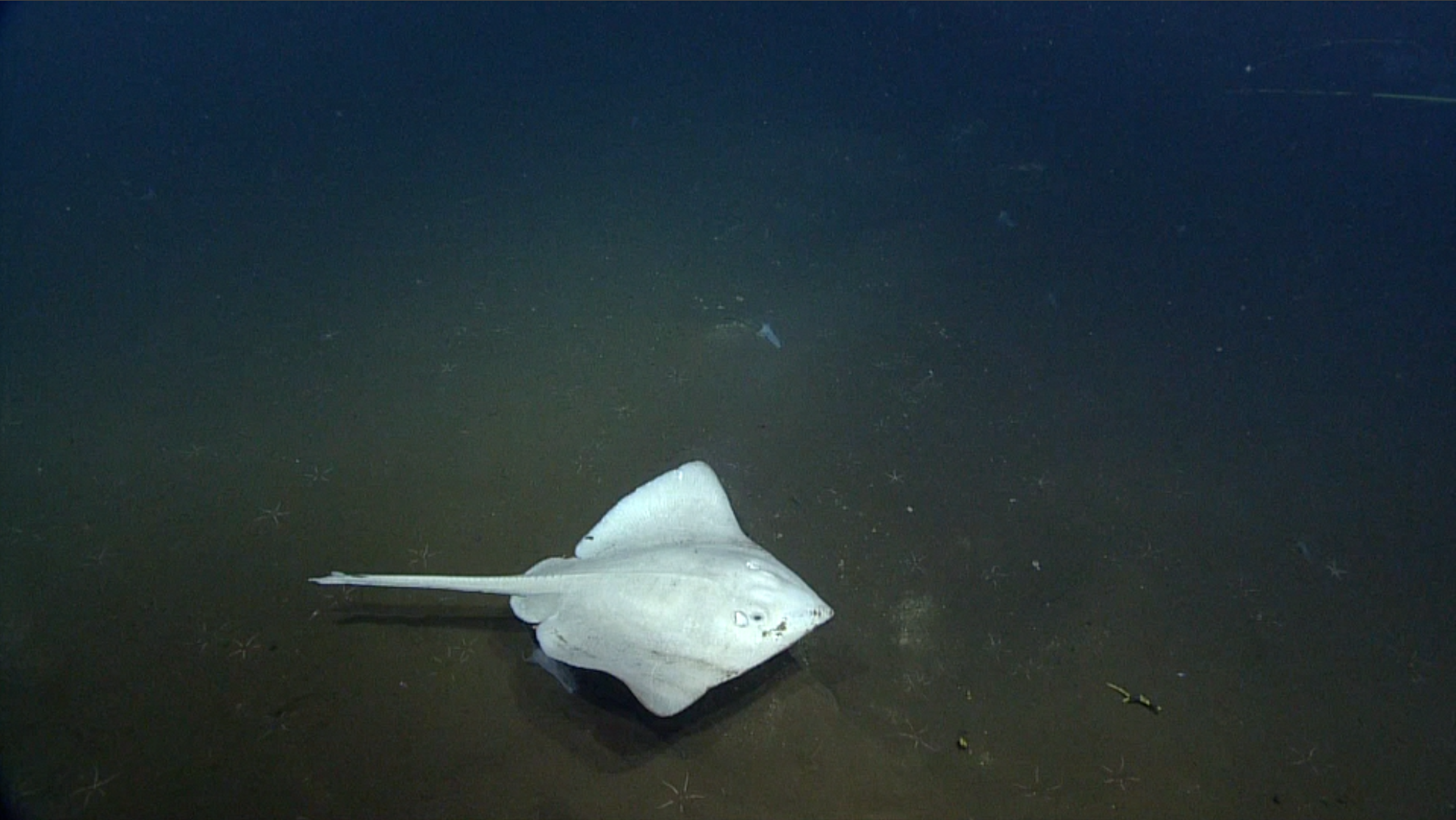Image Archive





























A titanium isobaric gas-tight sampler (IGT) is used to sample fluids with dissolved gases in a high temperature vent on the El Gordo metal sulfide chimney located in the International District Hydrothermal Field at ~ 1500 m water depth on Axial Seamount. The base of the cabled RAS fluid sampler and microbial DNA sampler mooring is in the background. Credit: UW/NSF-OOI/WHOI; V16.

The cabled digital still camera streams images of Jason (Dive J2-932) live back to shore in real time as the vehicle works at the active hydrothermal vent called 'El Gordo' in the International District Hydrothermal Field - depth is 1500 m, and >300 miles offshore. The hydrothermal fluid sampler, called the RAS, is shown to the left, which allows fluid samples and temperature to be taken for a year. The instrument can be run in "mission mode" where samples are preprogrammed, or in "sponse mode" where missions are interrupted by operators to take samples - such as was done during the eruption of Axial Seamount in 2015. Credit: UW/OOI-NSF/WHOI, V16.

A Hydrothermal Vent Cap at the top of the actively venting chimney called ‘El Gordo’, traps high temperature hydrothermal fluid. An intake nozzle from the mass spectrometer allows measurement of gas chemistry in real-time, sending data at the speed of light back to shore. Another nozzle sucks in vent fluids for sampling and for filtering of microbial DNA: the samples fluids and DNA are recovered during annual Cabled Array maintenance cruises for follow-on shore-based analyses. Credit: UW/NSF-OOI/WHOI; Dive J2-912, V16.

The wand of the temperature and resistivity sensor is embedded in 1-year old metal sulfide and sulfate minerals precipitated from hot hydrothermal fluid. This novel instrument, built by M. Lilley at the University of Washington, measures real-time changes in fluid temperature and resistivity as an analogue for chlorinity. Boiling vents often emit low-salinity, low pH fluids. Credit: UW/NSF-OOI/WHOI; Dive J2-912, V16.

Close up of the Remote Access Fluid Sampler (RAS) built by D. Butterfield at NOAA-PMEL-UW. A nozzle is installed in an active venting site on the El Gordo chimney. Controlled from shore, or by a mission plan, a pump sucks in hydrothermal fluid into sterile bags (and also onto filters for collection of DNA in a similar system above the RAS). During annual Cabled Array maintenance cruises, this coupled mooring is recovered and collected material analyzed, with results provide at oceanobservatories.org. Credit: UW/NSF-OOI/WHOI; Dive J2-212, V16.

A temperature probe (HOBO) installed by NOAA last year in the hydrothermal vent ‘Diva’ is now enclosed in the sulfate-rich, white mineral called anhydrite. The high temperature fluids at this site host very high concentrations of carbon dioxide being outgassed from the underlying magma chamber. Credit: UW/OOI-NSF/WHOI; Dive J2-912, V16.

A digital still camera (left), mass spectrometer (middle) and a fluid and microbial DNA sampler at the El Gordo vent in the International District Hydrothermal Field measure and sample fluids, animals, and microbes in this active processes within this hydrothermal system to understand linkages amoung seismicity (seismometers extend away from the field), venting and life in this extreme environment. Credit: UW/OOI-NSF/WHOI; Dive J2-212, V16.

A temperature-resistivity sensor, with its wand now embedded in a sulfate-rich chimney (white, right) sends real-time data to shore from the Escargot chimney, 5000 ft beneath the oceans' surface and >300 miles offshore. Resistivity is an analogue for fluid chlorinity. Numerous hydrothermal vents in the International District Hydrothermal Field at the summit of Axial Seamount are boiling. Credit. UW/OOI-NSF/WHOI; Dive J2-912, V16.

A digital still camera (left), mass spectrometer (middle) and hydrothermal fluid and microbial DNA sampler (right) document changes in animal life, gas and fluid chemistry, temperature, and chimney growth at the El Gordo vent site in the International District Hydrothermal Field at the summit of Axial Seamount - water depth is ~ 5000 ft (1500 m). Data are streaming live to shore 24/7. Credit: UW/OOI-NSF/WHOI, V16.

Final preparations on the whiched, instrumented Science Pod before it is latched under the belly of the ROV Jason for installation on the Shallow Profiler Mooring at Axial Base. Credit: M. Elend, University of Washington, V16.

A 12 pin electrical wet-mate connector on a junction box at the base of Axial Seamount awaits its mate during turning of the platforms and instruments at this site. The oil-filled mates, allow the ROV to disconnect and connect extension cables on platforms, junction boxes, and instruments without bringing the entire assembly to the surface. They are used heavily on our system to reduce operations and maintenance costs. Credit: UW/OOI-NSF/WHOI, DIve J907, V16.

The Titan manipulators on the ROV Jason conduct complex operations during installation of the Platform Interface Assembly hosting multiple instruments. The PIA is attached to the 200 m deep, 12 foot across platform on the two-legged Shallow Profiler Mooring at Axial Base. Credit: UW/OOI-NSF/WHOI, Dive J911,V16.

Krill surroung the small "cage" housing the cable connection from the Shallow Profiler at Axial Base to the extension cable connecting the Profiler to the power and communications. Credit: UW/OOI-NSF/WHOI, Dive J910, V16.

The new instrumented science pod, all bright and shiney, is installed on the Shallow Profiler Mooring at Axial Base. Credit: UW/OOI-NSF/WHOI, V16.

The ROV Jason surveys the Shallow Profiler platform located ~ 600 ft beneath the oceans' surface. Eighteen instruments on the platform and profiling science pod have been sending data live to shore for a year, all connected to the Internet. Both science pods have now been replaced during the annual, planned maintenance of this system. Operation of this infrastructure takes place at the University of Washington Operations Center in the School of Oceanography. Credit: UW/OOI-NSF/WHOI; V16.

The ROV Jason breaches the oceans surface latched into an instrumented Platform Interface Assembly that has been installed for a year on a Shallow Profiler Mooring at the base of Axial Seamount. Connected to the submarine cable, the instruments have been sending sending data live back to shore since summer 2015 from 600 ft beneath the oceans' surface. Credit: M. Elend, University of Washington, V16.

During Dive R1862, ROPOS attaches a line to the float on the deep profiler mooring at Axial Base in preparation for its recovery. Credit: NSF-OOI/UW/ISS; V15.

Tim McGinnis and Nick Michel-Hart of the UW Applied Physics Laboratory begin to disassemble and inspect the crawler recovered from the Deep Profiler Mooring at Axial Base. Credit: Mitch Elend, UW; V15.

The float atop the Deep Profiler Mooring at the base of Axial Seamount has become a habitat for schools of fish. Credit: NSF-OOI/UW/CSSF; ROPOS Dive R1860, V15.

Skadis Cauldron, which was venting huge masses of microbial material and fluid following the 2011 eruption, still emits minor flow of cloudy fluid three years after this event. Credit: NSF-OOI/UW/ISS; V15 Dive R1839.

A skate swims gently past ROPOS at the base of Axial Seamount, greater than 9000 ft beneath the ocean's surface. Credit: UW/NSF-OOI/CSSF; ROPOS DIve R1841, V15.

A first glimpse of the shallow winched profiler coming out of its docking station at the base of Axial Seamount. NSF/OOI/UW/ISS; Dive R1842; V15.

A digital still camera, mass spectrometer, and fluid and microbial DNA sampler installed at the El Gordo hydrothermal chimney, International District Hydrothermal Field, Axial Seamount. A small, 1-day old chimlet sprouts from the 280°C, gas-rich vent called Dive in the International District Hydrothermal Field. NSF-OOI/UW/ISS; Dive R1839; V15.

Collapse basins marked by columns, drainback features, and arches are common features in areas where lava ponded and spilled rapidly over the seafloor in 2011. A small, 1-day old chimlet sprouts from the 280°C, gas-rich vent called Dive in the International District Hydrothermal Field. Credit: UW/NSF-OOI/CSSF; ROPOS Dive R1839; V15.

A small, 1-day old chimlet sprouts from the 280°C, gas-rich vent called Dive in the International District Hydrothermal Field. Credit: UW/NSF-OOI/CSSF; ROPOS Dive R1839; V15.

A huge rattail, ~ 5 feet in length, swims slowly in front of the ROV ROPOS near the International District Hydrothermal Field at a depth of 5000 ft beneath the ocean's surface. This area has a higher abundance of these fish than observed elsewhere in the caldera, perhaps because of the larger size of the vent field and hence food source. Credit: UW/NSF-OOI/CSSF; ROPOS Dive R1729; V15.

A school of small fish greeted the ROV ROPOS during our first visit to this ~ 600 ft deep platform since it was installed in 2014. Credit: NSF-OOI/UW/ISS; Dive R1832; V15.

Pyconogonids are abundant on many sulfide structures in the vent fields within the caldera of Axial Seamount. These 8-legged anthropods are commonly found in areas where venting has stopped, leaving variably oxidized edificies. Here, they are associated with snails an a small scale worm ~ 1 cm; in length. Credit: UW/NSF-OOI/CSSF; ROPOS Dive R1836; V15.
- Anemone
- Animal
- Arthropod
- ASHES
- Axial
- Axial Base
- Axial Biology
- Axial Caldera
- Bacteria
- Basalt Lava
- BEP
- Biofouling
- biolgoy
- Biology
- Camds
- Camera
- Camhd
- Central Caldera
- Ciliates
- Cnidaria
- Coastal Biology
- Crab
- Deep Profiler Mooring
- Dive Highlights
- Eastern Caldera
- Echinoderms
- Endurance Array
- Engineering Team
- ENLIGHTEN 10
- Exploratorium
- Fish
- Geology
- HD Camera
- HPIES
- Hydrate Ridge
- Hydrates
- Hydrophone
- Hydrothermal Vents
- Illustration
- Inshore 80 Meters
- Instrument
- International District
- J-BOX
- Jason
- Jellyfish
- Junction Box
- K12
- Lava
- Mollusk
- Moorings
- Nodes
- Nudibranch
- Octopus
- OOI
- Oregon Offshore
- Oregon Offshore 600 m
- Oregon Shelf
- Oregon Slope Base
- People
- PN1B
- PN1D
- Polychaetes
- PPSDN
- Primary Node
- RASFL
- ROCLS
- ROPOS
- ROPOS Dives
- ROV Team
- RV Revelle
- RV Sikuliaq
- RV Thompson
- Salp
- Sample
- SC13
- Science Team
- Sea Cucumber
- Sea Star
- Sea Urchin
- Seafloor
- Seismometer
- Sensors
- Shallow Profiler Mooring
- Shark
- Shipboard
- Shore Station
- Slope Base
- Smoker
- Soft Coral
- Southern Hydrate Ridge
- Sponge
- Squid
- Students
- Students & Guest Participants
- Tmpsf
- Tubeworms
- VISIONS 11 Leg 1
- VISIONS 11 Leg 2
- VISIONS 11 Viewers
- VISIONS 13
- VISIONS 14
- VISIONS 15
- VISIONS 16
- VISIONS 17
- VISIONS 18
- VISIONS 20
- VISIONS 22
- VISIONS 23
- Visualization
